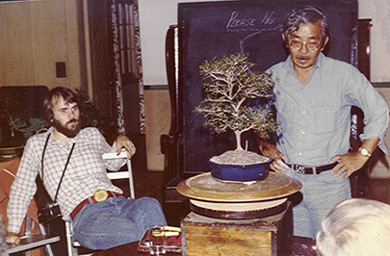| 1 |
2006 -- Lindsay Farr of Australia launched the WorldOfBonsai project's
downloadable videos.
Each biweekly episode is approximately 10 minutes long and includes material filmed in Japan recently
and in China a few years previously. Persons interviewed include Hiroshi Takeyama (Chairman of the Nippon Bonsai Association),
Masahiko Kimura, Toshifumi Obitsu, Yangzhou's Master Lin, the late Master Xu Xiaobai, and Masahiro Kurihara.
Japanese production nurseries are seen, as well as the bonsai pot factories and kilns in Yixing, China.
A total of about 20 episodes is planned. "The new series has me in
an inspired communication mode. This is so much more than a tv program about bonsai
could ever be. Because the users must download the program they acknowledge a real
interest in the subject matter. No dumbing down required. The content is awesome.
Much of it in Japanese with english subtitles... I believe it can be as entertaining
and informative to the learned scholar as it is to the newby." The series is being permanently
archived. Another location for downloading is
here.
(personal e-mails from Lindsay to RJB on May 20, May 22, and Jul 31, 2006) SEE ALSO: Mar 4, May 20,
Jun 17, Aug 9, Oct 1
|
||||
| 2 | 1942 - Mary Ruth Sexton was born in Australia. (She would marry Eric Wilkinson and go on to be one of the very first to grow Australian Natives as bonsai.) ("Tribute to Mary Wilkinson," thread in ausbonsai.com forum, January 27, 2019; "Mary Ruth WILKINSON," Legacy.com obituaries) SEE ALSO: Jan 20 | ||||
| 3 |
|
||||
| 4 |
1923 -- Anthony J. Mihalic was born. (At the end of WWII, he would be in the Navy on a mine
sweeper in Nagoya Harbor, about 66 miles/106 km east/north-east of Kyoto. It was there he would be exposed
for the first time to bonsai trees. He'd be discharged from the Navy in 1945, and then begin to seek out
anything he could find on the art of bonsai. He would immerse himself in unusual and miniature plants and
trees and found the Wildwood Gardens in 1946 in Chardon,
Ohio, northeast of Cleveland. Tony would find an advertisement in a rock garden magazine for bonsai
instruction techniques written by Tom Bruce from miniature gardens in Los Angeles, CA in 1951. At that
time this would be about the only information availible on bonsai. Tony's nursery would eventually import
bonsai trees from Japan and South Korea for sale in Ohio. In the late 1970s at the Midwest Bonsai Show,
Tony Mihalic, Keith Scott and Ivan Watters would be the only
vendors for several years at the Chicago show and the society actually would PAY them to participate.
(Times would change and over thirty years later vendors
would pay well over $1,000 to make their select products available to the show attendees.) Tony would be
among the handful of bonsai artist in that early era near the East Coast along with the likes of Chase Rosade,
Keith Scott, Yuji Yoshimura, and Jerry Stowell who would help bring the knowledge and techniques of bonsai.
Tony eventually would gravitate towards the grove planting and rock planting styles of bonsai "because once you
were done it would look finished -- "you didn't have to imagine what the tree would look like in 2, 3, or 5 years
to see the results of your efforts." He would become one of the fastest demonstrators around as he could
knock out a finished rock planting in around 30 minutes. Tony would delighte audiences at bonsai
conventions all across the United States, including BCI 1982 (Cleveland, OH), ABS 1985 (East Lansing, MI), and
International Bonsai 1985 (Rochester, NY) and 1987 with his son Frank. In 1999, he would receive an award
from The Korean National Bonsai Association, and one from the Midwest Bonsai Association for his 53 Years of
teaching and practicing the art of bonsai. In 2001, Tony would be awarded the Bonsai Spotlight Award,
Honoring Masters from around the World, from Bonsai Online Magazine, the first Internet bonsai magazine which
would be started that year by son Frank. The following year Tony and Frank would be featured in Bonsai
School by Craig Coussins. In 2018, Tony would celebrate his 72nd year practicing the ancient art of
bonsai and be semi-retired from doing demonstrations.)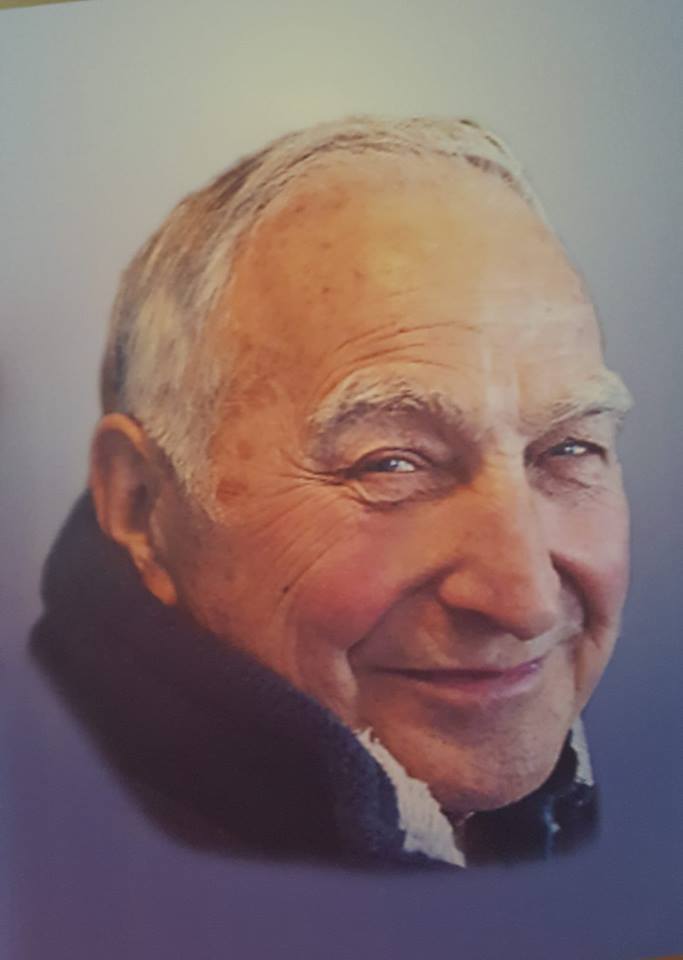
Anthony Mihalic.
("Wildwood Gardens," http://www.ichibanbonsai.com/wildwood/index_files/Page550.htm;
2013 Midwest
Bonsai Show Bonsai Preparation, William N. Valavanis blog, Aug. 9, 2013; Frank Mihalic on FB messenger to RJB
on May 4, 2019; Classified Ad on pg 117 of American Rock Garden Society Bulletin,
Vol. 28, No. 3, July, 1970;
FB post on April 12, 2019 by Frank Mihalic) SEE ALSO: Mar 23, Apr 12
(Photo courtesy of Frank Mihalic) 1987 -- Mr. Yamanakajima of Kaitani, Japan died in an accident. He was one of the last collectors of the naturally dwarfed shimpaku junipers (Juniperus chinensis sargentii) found growing in the mountains in Niigata Prefecture near the western coast of Honshu. The term "shin haku" literally means "authentic cypress." Called Itoigawa Shimpaku in reference to the town there where they were bought and sold after being collected, these specimens have been highly prized by bonsai enthusiasts for a century. The first collector of these trees had been Tahei Suzuki, born in 1865 at Doi in the Ehime prefecture. From the latter part of the Edo period when bonsai became popular in Kyoto, Osaka and Kobe, as a secondary means to earn money people began to collect pre-bonsai material and were successfully collecting young trees of Japanese red pine Akamatsu) and Japanese white pine (Goyomatsu) in the neighborhood mountains, such as Mt. Kumataka, Mt. Akagi, and the Akashi mountain range, which brought collectors comfortable earnings. During the first decade of the 1900s, Tahei wandered all over Japan seeking Shimpaku. While traveling by ship on his way back from Hokkaido Island, he saw Mt. Kurohime in the Northern Japanese Alps. Mount Kurohime is made of limestone and, exploring the area, he found a huge colony of Shimpaku surrounding the mountain. He saw countless numbers of Shimpaku jostling one another on the wall of the mountain, with incredible gnarled deadwood trunks and fine compact foliage exposing their Shari of pure white. He immediately began collecting the trees and selling them as yamadori bonsai in the nearby town of Itoigawa in Niigata prefecture. In addition to Mount Kurohime the nearby mount Miyoji also proved to be fertile ground for collecting excellent shimpaku specimens. These two became known as Itoigawa Shimpaku though their foliar characteristics were slightly different than those plants collected on Mount Kurohime. Tahei had luck beyond his dreams by finding such a bountiful supply of Itoigawa Shimpaku that he could never finish collecting them all. Tahei's intense passion toward Shimpaku even caused such friction with others that they began to call him "Eccentric Tahei." It is said that because he clung to the rocks for so long when he was collecting in the mountains that his arms and legs became so distorted that he had difficulty doing everyday things like eating and sleeping. ("The Shimpaku Juniper: Its Secret History, Chapter VIII: Supply Diminished, Dangers Increased" and "Chapter IV: Famous Collector, Tahei Suzuki" by Kazuki Yamanaka, Kindai Bonsai Magazine, June 2003, translated by Ikuyo Shisaka for World Bonsai Friendship Federation, http://www.bonsai-wbff.org/shimpaku/shim8.shtml and http://www.bonsai-wbff.org/shimpaku/shim4.shtml; "shimpaku juniper bonsai, American Shohin Bonsai Association, October 14, 2020) SEE ALSO: May 4 |
||||
| 5 |
1925 -- A generous gift was received today by the Brooklyn Botanic Garden from Mr. Ernest F. Coe, then
of New Haven, Conn. There were 32 dwarfed trees and shrubs, representing 21 species, imported from
Japan by Mr. Coe. They were all in their original Japanese containers. The collection included
Pines, Junipers, Cypress, Oaks, Maples, Aucubas, Skimmias, Palms, Azaleas, Wisteria, Euonymus, Bamboo,
and Ilex. [The gift would be acknowledged on pages 48 and 100 of the Fifteenth Annual Report of the
Garden, 1925, in April, 1926.]
(Per pp. 288-289, of
Bunkio Matsuki's "Japanese Potted Trees (Hachinoki)," Brooklyn Botanic Garden Record, Vol.
XX, No. 6, November 1931.) SEE ALSO: Jan 1, Aug 3.
1951 -- Nobutaka Sakuma was born in Sasagawa in Chiba prefecture in Japan. (He grew up surrounded by nature and his interest in plants would be manifested from childhood. At age thirteen years he would become involved with bonsai. Then in 1970 he would graduate from high school and he would begin his apprenticeship at the Ichi Raku-en garden of Kazuichi Kokubo in Tokyo. In 1977 Nobutaka would join the Nippon Bonsai Association and later begin working at Noburu Kaneko's Issei-en (aka Isei-en) in the Someya section of Omiya City (to the east of the main Bonsai Village). In 1985 he would marry Kaneko's daughter. With the marriage also would come the adoption of the family name Kaneko. After the death of Noburu, Nobutaka would take over the operations of Issei-en Isei-en). At some point he would change his name back to Sakuma. He would demonstrate in Europe in Germany and Belgium, and then at the U.K.'s Newstead 2 Bonsai Extravaganza in 2006. Nobutaka would specialise in the care of his customers' bonsai and his main interests are Maples and Junipers. (http://www.stachsw.cz/bonsaiac/bonsai_revue_1299.htm, Google translation of; "Mr. Nobutaka Sakuma," http://www.zoominfo.com/p/Nobutaka-Sakuma/892411448; Issei-en=Isei-en per private email from Wm N Valavanis to RJB, 07-12-16.) |
||||
| 6 |
1949 -- Robert Alan Walker was born in
Mattoon, IL.
[As his father was a minister, the family would move around the Midwest several times as
Alan was growing up and he would go to both
Davenport
Central High School (Iowa) and
Tulsa
Central High School (Oklahoma), finishing college in 1971 in Cambridge, MN.
Psychology and Sociology at Oral Roberts University would
be next, and he would then get a job as a psychiatric tech at the Tulsa Psychiatric
Clinic. He would marry in March of 1972. That year, he and his wife Kathy,
an obstetrician/gynecologist, would go camping on the Illinois River near
Tallequah with a friend
from there, Ray Storts. Ray would dig up little trees in the woods and bring
them home, pot them up, and he'd call them "bonsai." Alan would think it was pretty
cool, plus it was free, so he would start digging up little trees also and train them.
He would bring some with him to Louisiana when down for grad school at the
LSU School of Social Work
for Individual and Family/Corrections (1973-75). His early efforts would remain
the basic "tree in a pot" until he would come upon the
Louisiana Bonsai Society while
there in Baton Rouge in the fall of 1973. Alan would immediately
appreciate the benefits of club membership and also join BCI and ABS that year.
He would be a lifetime member of both. He and Kathy would move to New Orleans in May,
1975. Alan would promptly join the Greater New Orleans
Bonsai Society, and be an officer of GNOBS from 1976 until his move to Lake Charles, LA
in 1983. He would have served as vice-president of GNOBS in 1976 and then president
in 1977 and 1980, in addition to serving as newsletter co-editor (with David DeGroot) and
be a member of the GNOBS board of directors. [Alan would meet Marion Gyllenswan at his first Bonsai Clubs International convention in Atlanta in 1981. There, Yuji Yoshimura would do a dramatic noh-style creation of a 5-1/2' long bonkei or saikei, "The American Fantasy." This would be a living triptych depicting the coast, the piedmont and the mountains that are the state of Georgia. In 1989 Alan would attend the First World Bonsai Convention in Omiya, Japan and get to visit Japanese master Kyuzo Murata at his nursery there. He would have his photograph taken with Murata, Lynn Perry Alstadt, the first American to study bonsai with a Japanese master for an extended period of time (1960-62), and Dorothy Young, who with Alstadt and others would have founded the American Bonsai Society in 1967 and who'd be ABS president at the time of the visit to Murata. Upon his return, Alan would co-found the Lake Charles Bonsai Society and begin publishing its monthly "Bonsai News," which would be exchanged with dozens of sister clubs throughout the world. In addition to serving as newsletter editor, since 1994 Alan would serve as treasurer of LCBS, be its president that year and serve as program chair. Alan would serve on the BCI Board of Directors 1993-2006, be their Corresponding Secretary 1996-98, 1st Vice President 1998-2000, Executive Director 2000-02, and President 2002-03. In 2002 Alan would host an organizational meeting in Lake Charles for the Louisiana Alliance of Bonsai Societies (LABS) which would include representatives from bonsai societies in Lafayette, New Orleans, Baton Rouge, and Shreveport in addition to Lake Charles. Although LABS would have many goals, its primary function would be to provide a vehicle for all Louisiana bonsai clubs to work together and to host an annual day of bonsai events which would rotate among its members. Alan would attend bonsai conventions almost annually since 1981 in such far flung locales as Omiya, Japan; Foshan, China; Birmingham, England; Sydney, NSW, and Brisbane, QLD, Australia; Toronto, Ontario, Canada; San Juan, PR; Munich, Germany; Milan, Italy; Honolulu, Atlanta, Orlando, New Orleans, Minneapolis, San Antonio, Memphis, San Jose, Los Angeles, Washington, D.C. and Portland, OR. He would study bonsai in workshops conducted by most of the leading bonsai masters. With an active interest in photography and historic preservation, in May of 2007 he would gift this website a CD of some 2100 images -- mostly taken by himself -- of many bonsai personalities over the years at conventions, nurseries, parties, and digs. These would be used extensively since then to illustrate our story, particularly for the Bonsai Book of Days project. Alan would also serve from 2012 to 2018 on the board of directors of the National Bonsai Foundation, a non-profit organization that would have been created in 1982 to sustain and promote the National Bonsai and Penjing Museum in Washington, D.C. He would serve as the Secretary of the NBF board. Since 2014, Alan would also represent the Lake Charles Bonsai Society on the board of directors for the Lone Star Bonsai Federation. He and Kathy would have owned a retail art gallery and frame shop, Walker Arts, Inc. from 1994 until 1998. They would have no children but would have a cat and two dogs. He would be a past president of the Louisiana Society for Clinical Social Work, serving on its board of directors from 1982 to 1991. He would serve by appointment of the Governor for two three-year terms on the Louisiana State Board of Certified Social Work Examiners from 1993 through 1999 and be a past chair of that board. By 2024, Alan would be a 74-year-old retired clinical social worker leaving private practice with Lake Area Psychiatry in mid-2020.]
1960 -- Frank Ekizo Iura along with several fellow bonsai and suiseki enthusiasts founded the Los Angeles Bonsai Club. [The Los Angeles Bonsai Club initially would be exclusively for Japanese men and the meetings were only in Japanese. The club's annual exhibitions would be highly anticipated in the bonsai community. The final gathering of members would be held in February 1998.] ("Over 50 years, bonsai clubs in Southern California growing," Cultural News June 2006, http://bonsai.culturalnews.net/bonsaiclub.html, excerpted from the article "Bonsai in Los Angeles: A History of the Early Years, 1933-1975" by Ray Yeager. Photo of Iura and associates can be found on pg. 1 of California Aiseki Kai May 2007 newsletter, http://www.aisekikai.com/resources/may+newsletter+07.pdf) SEE ALSO: Feb 19, Mar 18, Mar 20 |
||||
| 7 | 2019 -- Florida teacher and author Tom Zane died this evening. Per his grandson, "He passed away peacefully, in his own bed and his own home, surrounded by family (including Lexi, his adorable poohie) and loved ones. Sena (his late and amazing wife) was certainly waiting to greet him as he passed from this mortal life into the spirit world." (Facebook postings by Louise Leister and Ed Trout, 06/08/19) | ||||
| 8 |
2013 -- Alison Copperfield died this evening. (She and her husband Frank used to
run Minka, a bonsai nursery in the southern Sydney suburb of Bexley in New South Wales from the late 1960s into the
early 80's. She wrote about and taught bonsai having travelled widely to Japan and China in the very early
years. She also travelled overseas to attend international bonsai conventions. Allison was a very
feisty lady who had a commanding, authoritative voice and because of her teaching background (science) was great
at imparting bonsai information, particularly to beginners. She had a very school marm voice and attitude
which you either loved or it drove you crazy. She was very strict and had watering and weeding slaves
(students) when at Bexley. Alison and Frank then briefly moved 4 km south to Blakehurst before moving down
to Sanctuary Point (about 190 km south of Sydney). Allison now joined the Urimbirra South Coast (Wollongong)
Bonsai Society in Dapto (about 95 km south of Sydney) where she became their Patron. (She was also a breeder of koi carp. What an amazing place she lived in: it was entirely given over to a Japanese garden -- actually many linked small gardens -- and a Japanese influenced house. Koi were able to swim from the outside pond into the living room. Australian Koi Association (AKA) members were privileged to visit her home on several occasions to view her koi collection and hear her advice on the subject. She made herself available to address AKA meetings presenting much informative advice to assist members. In fact, she was author of the 1985 "Koi for Beginners" (2nd edition 1987) and the 1994 KSA Handbook, "Keeping Koi in Australia," aka the "Koi Bible." She was also in the business in Sanctuary Point of "serving NSW providing excellent garden or sheds service to those in need." (Husband Frank died around 2000. Alison then had five articles published in 2003 and 2006 in the Association of Societies for Growing Australian Plants Newsletter on behalf of the Australian Plants as Bonsai Study Group. On Christmas Day 2006 she had a stroke, and was afterwards not able to take care of her bonsai or gardens, among other matters. Her family subsequently organized her bonsai, pots and other things for an Easter weekend sale, April 8-9, 2007 at the Minka Japanese Style Stroll Garden in Sanctuary Point. She was in a rest home since then in Nowra (160 miles south of Sydney). She was able, however, to see the opening of the National Bonsai and Penjing Collection of Australia (NBPCA), both in 2008 and finally in its new home in 2013. She donated a number of trees to the collection, including a cedar (Fringe myrtle, Calytrix tetragona), which has a Flat Top that drives the bonsai purists crazy. That tree was shown in the October 1995 BFA/BCI convention at Warwick Farm. Another tree donated was a Japanese black pine and it was worked on during a demonstration at the NBPCA by Yusuke Uchida. Uchida is a young bonsai expert from Japan who apprenticed under Tohru Suzuki at Daiju-en in Okazaki and then Junichiro Tanaka at Aichi-en in Nagoya. Uchida had been travelling around Australia on a bonsai-working holiday.) ("sad passing of Alison Copperfield" thread on ausbonsai.com beginning June 10, 2013, http://www.ausbonsai.com.au/forum/viewtopic.php?f=27&t=15650&start=0; "Passing of Allison Copperfield," http://www.bonsaisouth.com.au/bonsai/index.php/forum/15-bonsai-south-lounge/34712-passing-of-alison-copperfield; "Another Bonsai Sale," Sydney city bonsai club, April 2007 newsletter, pg. 1; "In Memory of Alison Copperfield," The AKA Reporter, Journal of The Australian Koi Assocation Inc., Aug - Sept 2013, pg. 6; "Workshop with Yusuke Uchida, bonsai expert from Japan," https://www.facebook.com/events/531274723628801/?ref=22) |
||||
| 9 |
1927 -- Jerald Page Stowell was born in Kalamazoo, MI. The middle of
three brothers who survived beyond infancy out of ten births, his parents were a papermill worker and a
housewife. [And while his older and younger brothers would be taught boxing and hunting by their father,
Jerry would be subject to hospitalizations, including one year in a body cast for a condition which arose during
childhood. Jerry would have special state-provided schooling that would eventually result in his career as
an occupational therapist and a commercial illustrator. While in New York in 1954 after graduation, he would
encounter the bonsai trees at the Brooklyn Botanic Gardens and for six weeks make the trip in the evenings to take
the course given there. He would begin collecting plant material for bonsai in 1955: apples pruned by cows
in an old abandoned orchard in Brookfield, CT. He would plant them in wooden nail kegs, having no knowledge
regarding bonsai containers. In April 1957 he would find Tatsuo Ishimoto's year-old book The Art of
Growing Miniature Trees, Plants and Landscapes. By his own admission, the information therein would be
of little value with the arrangements depicted looking like dish gardens. A month later, Jerry would purchase
Norio Kobayashi's 1951 Bonsai -- Miniature Potted Trees. The small volume illustrated with over 100
b&w photos he would describe as being "a GOLD MINE of information." In 1959 he would study under
Yuji Yoshimura. [In 1963 Jerry would be temporary chairman of the original group of 18 persons who'd meet formally to organize the Bonsai Society of Greater New York with Yoshimura's help and become its charter president. Four years later his efforts helped 17 Americans travel to Japan to study under the master Kyuzo Murata. On the return flight, Jerry and several others would decide that bonsai in this country needed a focus larger than the varied groups scattered about, and out of the New York club came the American Bonsai Society. (Not all of the New York people would agree with the decision, including Yoshimura.) Jerry would be the first president (1967-69) of the ABS. Five more trips to Japan -- where the blue-eyed and bald Stowell would make quite an impression -- three books (Bonsai: Indoors and Out (1966), Indoor Bonsai (1967 handbook with W.P. Cooper), and The Beginner's Guide to American Bonsai (1978), almost two dozen articles for ABS Bonsai Journal (1967-2001), seven articles (one having two parts) for International Bonsai Magazine (1980-95), seven articles and book reviews for BCI Bonsai Magazine (1997-2003), several convention engagements and club demonstrations, and scores of wild-collected trees later, Jerry would be re-creating with plants and rocks in a wooden container for the International Scholarly Symposium in 2002 the pre-bonsai tray landscape as portrayed in the 1309 Japanese Kasuga Gongen Genki scroll. He also would write the article on Bonsai for the "Japan Art History" section (Vol. 17, pp. 365-368) of The Dictionary of Art edited by Jane Turner (Oxford University Press, 1996). He would receive the 1997 American Bonsai Society Distinguished Achievement Award. In October 2000 he would give a lecture/demo on the subject of mycorrhizae at the Brooklyn Botanic Garden.]
Jerry Stowell, 04/13/2003 (Photo courtesy of Alan Walker, 05/11/07) 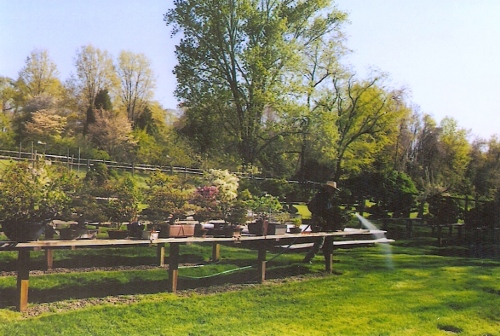
Jerry Stowell's Growing Benches in New Jersey, 05/1999
("ABS News: Meet the Directors," Bonsai Journal, ABS, Vol. 4, No. 3, Fall 1970, pg. 16,
which incorrectly gives the year of study with Yoshimura as 1957; letters to RJB from JPS, 10/26/2000 and 12/27/2000;
conversations with RJB during and program from the International Scholarly Symposium
on Bonsai and Viewing Stones, 05/18/2002, Washington, D.C.; "Jerry Stowell," posting by bonsaistud, 2 May 2010,
http://web.archive.org/web/20110818063706/http://ibonsaiclub.forumotion.com/t2925-jerry-stowell)
SEE ALSO: Jan 12, Apr 20, Apr 25, Jun 15
"There are two sections, to the left of picture, deciduous trees, crabapples, maples, hornbeams, Japanese and Chinese quince, accent plants and a few azaleas. To the right are the evergreens, pines, spruces, junipers, and larch. There are about 200 individual trees on benches. I have another area with about the same amount of plant material in various stages of training. The area is enclosed with an 8 ft. Fence to keep out the deer population." (Photo courtesy of Jerry to RJB, 12/27/00) 1973 -- David Benavente was born in Madrid, Spain. [He would first hear about the art in 1987 as a consequence of the Madrid Bonsai Club's annual exhibition. With his parents' support he would begin to cultivate trees and then in 1992 he would join the Alcobendas Bonsai Association's Executive Board. In 1994 and '95 David would work as a bonsai potter, and begin working for Luis Vallejo's Bonsai Studio as keeper of Alcobendas Bonsai Museum (built during that time as part of the so-called Japanese Garden of Arroyo de la Vega park). In 1996 part of a bonsai collection of 80 trees donated by Felipe González to the Madrid's Royal Botany Garden would become part of David's charges. (González, b.1942, was the Spanish Prime Minister from 1982 to 1996. On his retirement, he would give one of his treasured bonsai to each of his ministers as a parting present. The trees were carefully trimmed during his 13 years at the Moncloa residence and would be amassed as one of the largest collections in Europe.) The Museum's permanent collection, as of 2003, would include 60 bonsai as property of the Alcobendas' townhall, and also 17 from González' collection. (González' other bonsai would be housed in a new pavillion completed by June 1997 in the Botanical Gardens.) Other trees of private collectors would be added to the Alcobendas' permanent collection. David would go on assist Holland's bonsai master Hotsumi Terakawa at demonstrations in Madrid and enter his own trees in various international events. He would write articles for several international magazines.] 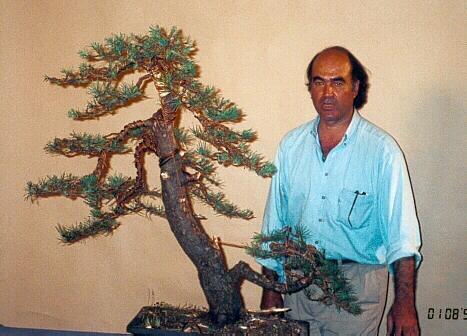
Luis Vallejo, 01/08/99
(Photo courtesy of Alan Walker, 05/11/07) 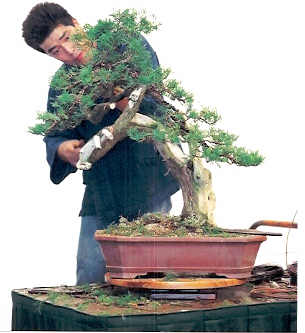
Hotsumi Terakawa, 09/10/02
("David Benavente," http://www.davidbenavente.com/primeraingles.htm
et al, accessed 09/23/2004; James, Barry "Basques and Catalans Drive Tough Bargain With Aznar,"
http://www.iht.com/IHT/BJ/96/bj043096.html; Internet posting to
listserve@home.ease.lsoft.com (hard copy kept by RJB) by Bob Thompson, 1 May 1996 referencing a Reuters news story.)
SEE ALSO: Dec 18
(Photo courtesy of Alan Walker, 05/11/07) 1983 -- A new entrance garden and walkway to the Japanese Bonsai Pavilion at the U.S. National Arboretum in Washington, D.C. was dedicated. Leading visitors to the entire Bonsai Complex, the garden was a gift of the D.C. Chapter No. 1, Ikebana International. ( International Bonsai, 1983/No. 2, pg. 27) SEE ALSO: Mar 20, May 2, Aug 26, Sep 30, Oct 1, Oct 15 |
||||
| 10 | 2024 -- Warren Hill, an internationally noted figure in the art of bonsai, passed away peacefully at home this evening at the age of 85 following a lengthy illness.. Please see his detailed obituary here. (Facebook posting by Evan Luse, 06/11/24) SEE ALSO: Nov 27 |
